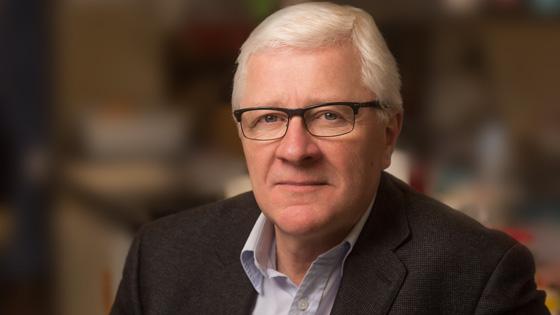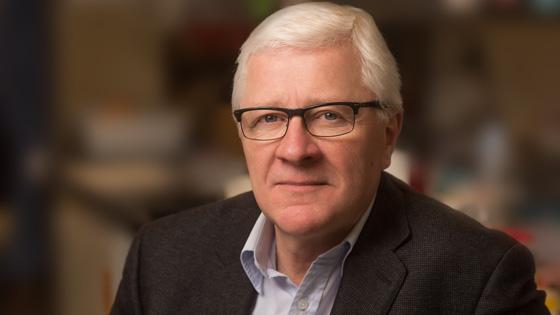
Credit: University Health Network
(TORONTO, Canada – June 28, 2017) – Leukemia researchers led by Dr. John Dick have traced the origins of relapse in acute myeloid leukemia (AML) to rare therapy-resistant leukemia stem cells that are already present at diagnosis and before chemotherapy begins.
They have also identified two distinct stem-cell like populations from which relapse can arise in different patients in this aggressive cancer that they previously showed starts in blood stem cells in the bone marrow.
The findings – published today in Nature (doi:10.1038/nature22993) – provide significant insights into cell types fated to relapse and can help accelerate the quest for new, upfront therapies, says Dr. Dick, a Senior Scientist at Princess Margaret Cancer Centre, University Health Network, and Professor in the Department of Molecular Genetics, University of Toronto. He holds the Canada Research Chair in Stem Cell Biology and is Director of the Cancer Stem Cell Program at the Ontario Institute for Cancer Research. This study was primarily undertaken by post-doctoral fellow Dr. Liran Shlush and Scientific Associate Dr. Amanda Mitchell.
"For the first time, we have married together knowledge of stem cell biology and genetics – areas that historically have often been operating as separate camps – to identify mutations stem cells carry and how they are related to one another in AML," says Dr. Dick, who pioneered the cancer stem cell field by identifying leukemia stem cells in 1994. A decade ago, he replicated the entire human leukemia disease process by introducing oncogenes into normal human blood cells, transplanting them into xenografts (special immune-deficient mice that accept human grafts) and watching leukemia develop – a motherlode discovery that has guided leukemia research ever since.
The researchers set out to solve the mystery of AML relapse by analysing paired patient samples of blood taken at the initial clinic visit and blood taken post-treatment when disease recurred.
"First, we asked what are the similarities and differences between these samples. We carried out detailed genetic studies and used whole genome sequencing to look at every part of the DNA at diagnosis, and every part of the DNA at relapse," says Dr. Dick. "Next, we asked in which cells are genetic changes occurring."
The two-part approach netted a set of mutations seen only at relapse that enabled the team to sift and sort leukemic and normal stem cells using tools developed in the Dick lab a few years ago to zero in on specific cell types fated to relapse.
"This is a story that couldn't have happened five years ago, but with the evolution of deep sequencing, we were able to use the technology at just the right time and harness it with what we've been working on for decades," he says.
Today's findings augment recent research also published in Nature (Dec.7, 2016) detailing the team's development of a "stemness biomarker" – a 17-gene signature derived from leukemia stem cells that can predict at diagnosis which AML patients will respond to standard treatment.
Dr. Dick says: "Our new findings add to that knowledge and we hope that we will soon have a new biomarker that will tell whether a patient will respond to standard chemotherapy, and then another to track patients in remission to identify those where treatment failed and the rare leukemia stem cells are coming back.
"These new kinds of biomarkers will lead to new kinds of clinical trials with targeted chemotherapy. Right now, everybody gets one size fits all because in AML we've never had any opportunity to identify patients upfront, only after they relapse. Now we have the first step to identify these patients at the outset and during remission."
###
The research was funded by the Ontario Institute for Cancer Research, the Cancer Stem Cell Consortium via Genome Canada and the Ontario Genomics Institute, the Canadian Institutes of Health Research, the Canadian Cancer Society, the Terry Fox Foundation, a Canada Research Chair and The Princess Margaret Cancer Foundation.
About Princess Margaret Cancer Centre, University Health Network
The Princess Margaret Cancer Centre has achieved an international reputation as a global leader in the fight against cancer and delivering personalized cancer medicine. The Princess Margaret, one of the top five international cancer research centres, is a member of the University Health Network, which also includes Toronto General Hospital, Toronto Western Hospital, Toronto Rehabilitation Institute and the Michener Institute for Education; all affiliated with the University of Toronto. For more information, go to http://www.theprincessmargaret.ca or http://www.uhn.ca .
Media Contact
Jane Finlayson
[email protected]
416-946-2846
@UHN_News
http://www.uhn.on.ca/
Related Journal Article
http://dx.doi.org/10.1038/nature22993
############
Story Source: Materials provided by Scienmag





